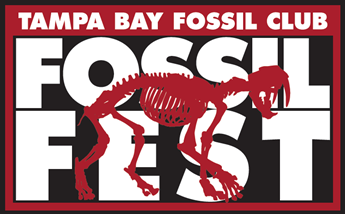The Pre-History of Florida
Relatively little is known about the history of Florida during the
Paleozoic Era (550-225 million years ago). Most geologists agree
that Florida, along with the rest of the southeastern United States
and Mexico, were part of the super-continent of Gondwana. Gondwana
included Africa, South America, Australia and Antarctica along with
parts of Europe and Asia. At the same time, North America, Europe
and Asia were combined into another super-continent called Laurasia.
About 300 million years ago these two land masses collided forming
one great super-continent called Pangea. Florida was in the middle
of this huge landmass, thousands of miles from any ocean.
In the early Mesozoic Era, during the Triassic Period (225-190
million years ago) Pangea began to break apart through a process
called rifting. Rifting stretches continental crust until it breaks,
and causes earthquakes and volcanic eruptions. As Pangea separated,
rifting began in a northeast-southwest line running from Charleston,
South Carolina through Savannah, Georgia to an area near the
Apalachicola river in the Florida panhandle. If rifting had
continued in this area, then most of Florida and part of Georgia
would have separated from North America along with South America
and Africa. In the early Jurassic Period however, rifting shifted
to an area east of the Bahamas and stopped in Georgia and the
Florida panhandle. By about 175 million years ago the newly opened
Atlantic Ocean and Gulf of Mexico were between Florida and the
other continents. Throughout the Triassic, Jurassic and even into
the early Cretaceous Periods, about 125 million years ago, much of
northern Florida remained above sea level and probably would have
been inhabited by dinosaurs, however, no dinosaurs fossils have
been found since the rocks that would contain them are deeply buried
beneath younger deposits. Rising sea levels during the Jurassic
would have submerged the southern part of Florida by midway through
the period and by the mid-Cretaceous, Florida, along with the
southern half of Georgia and Alabama, were underwater.
For nearly the next 100 million years Florida remained submerged.
In the Oligocene Epoch about 30 million years ago, when global
cooling caused sea levels to fall, northern Florida emerged from
the sea. The oldest known fossils of terrestrial vertebrates were
found near Gainesville and date from this time. Later in the
Oligocene sea levels rose and Florida was submerged once again.
Sea levels fluctuated considerably over the next 24 million years
and at times of higher sea level, much, if not all, of Florida was
submerged. At other times the sea was close to modern levels and
parts of the northern peninsula and panhandle were emergent. During
the Miocene Epoch (26-5 million years ago) the South American plate
was again drifting north, slowly uplifting the southern peninsula.
This, along with sands and clays eroded from the Piedmont highlands
of central Georgia and Alabama, created what is now south and
central Florida. By the Pliocene, North and South America were
joined by the Panamanian Isthmus, disrupting ocean currents and
causing widespread continental glaciation to begin. The last major
sea level high stand was 4.5 to 2.5 million years ago, when Florida
was submerged for the last time in geologic history.
The next 2.5 million years are know as the Ice Age. Continental
glaciers had advanced and retreated many times from the poles, at
times covering all of Canada and the northern United States. Ice
piling up on the continents caused sea levels to fall as much as
400 feet. Florida, in these times of glaciation, had a climate
similar to that of Virginia today, with annual snowfall. With lower
sea levels, Florida was more than twice as wide as it is today. St.
Petersburg would have been more than 75 miles from the Gulf of
Mexico during this time. What is now Tampa Bay, and far beyond,
would have been a combination of palmetto landscape, grassy plains
and woodlands, dotted with lakes and crossed by winding rivers.
For animals seeking refuge from the bitter cold of the north,
Florida was a welcomed haven. Between times of glaciation, the sea
level and climate were close to that of today. During this time
Florida’s wildlife would have included: antelope, bears, bison,
deer, gi ant beavers, giant armadillos, ground sloths, glyptodonts,
horses, lions, llamas, mammoths, mastodons, peccaries, saber-tooth
cats, tapirs, wolves, alligators, crocodiles, and many others.
Man first inhabited Florida during the last period of glaciation,
about 10 to 15 thousand years ago. Many Paleo-Indian artifacts have
been found in Florida. These Florida natives developed several
sophisticated cultures and thrived up until about 500 years ago
when the Spanish explorers arrived. None of these native peoples or
their cultures survived this encounter. In the last 12,000 years
there has been a mass extinction of many of the megafauna (large
vertebrate animals weighing more than 100lbs) not only in Florida,
but throughout North America and in some cases, worldwide. There
are several schools of thought on the cause(s) for these
extinctions. One opinion is that these animals were unable to
adapt to the climate changes at the end of the last glaciation
period and subsequent changes in vegetation. Another opinion is
that proficient human “big-game” hunters caused the animal
populations to drop below a sustainable level. Some believe it was
a combination of th e two, while others think disease played a
role. We may never know the answer to this mystery, but surely the
world is a poorer place with their loss.
The Tampa Bay Fossil Club invites you to join us in our quest for
knowledge of the pre-history of Florida. Join us on field trips as
we hunt for the fossils from the long lost creatures that once
inhabited our area. Meet with us monthly as we discuss and ponder
the mysteries that pre-historic Florida poses.
Join us!
Written by Robert Page
Former Director, TBFC


